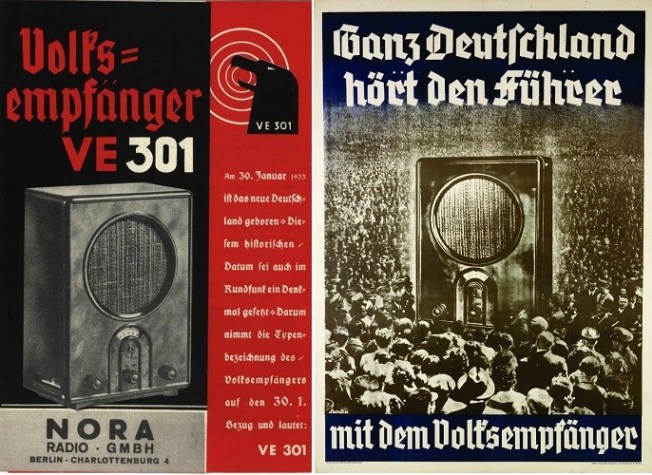
If today a certain similar project was carried out, then it would probably be a “people's smartphone”. I give such a comparison because, being a luxury item in the 20s and an attribute of high status, for the beginning of the 30s a radio receiver became an urgent need, something similar was with smartphones. It is important to note that the propaganda goals and ideological reasons for the release of such receivers had a different effect on their history, which I also wrote a few words about. But first things first.
If suddenly someone in this material seems to propagate Nazism, incite hatred, praises to dictatorial regimes - I inform you: this is not there and cannot be. Images and text do not pursue propaganda. The symbols of the Third Reich, the Nazi Party and Nazi Italy of the time of Mussolini, the text of the article, as well as any facts presented in it, are given exclusively for historical purposes (a reliable reflection of historical reality, a statement of facts). An assessment of the actions of the leadership of countries and political parties is given in the article solely in relation to the mass production of electronics and everything connected with it.
Italian beginning
Today, the German “folk radio” is widely known, and many believe that it was the “gloomy German genius” who created the “people's brainwash.” However, this is not quite true. The Italians were the first, as in Germany, the need for the radioification of the whole country appeared with the advent of the dictator. Benito Mussolini and the Fascist Party were in dire need of effective propaganda, a radio opportunity. But radios in Italy at that time were expensive and the vast majority of Italians simply could not afford them. This shortage was especially felt in the countryside, where a substantial part of the Italian population lived. Mussolini often repeated: "The village needs a radio." The Duce’s plan to brainwash the rural population was frustrated.

To solve the problem, on May 1, 1931, the Italian Ministry of Communications announced a competition to create a radio for the village. As planned, it was supposed to be a relatively simple to manufacture, massive, inexpensive device that would entertain the villagers and bring to them the fiery speeches of the dictator throughout Italy. The device was developed by 1932, after which, in the next competition, manufacturers were selected for state orders and the first series were launched.
“Rural Radio” for Mussolini
Interestingly, the first “folk” radios “Radio rurale” were called, in the literal translation “Rural Radio”. Technically, the devices were single-band, five-tube monsters of the superheterodyne type, i.e. converting the received signal to a fixed frequency signal.
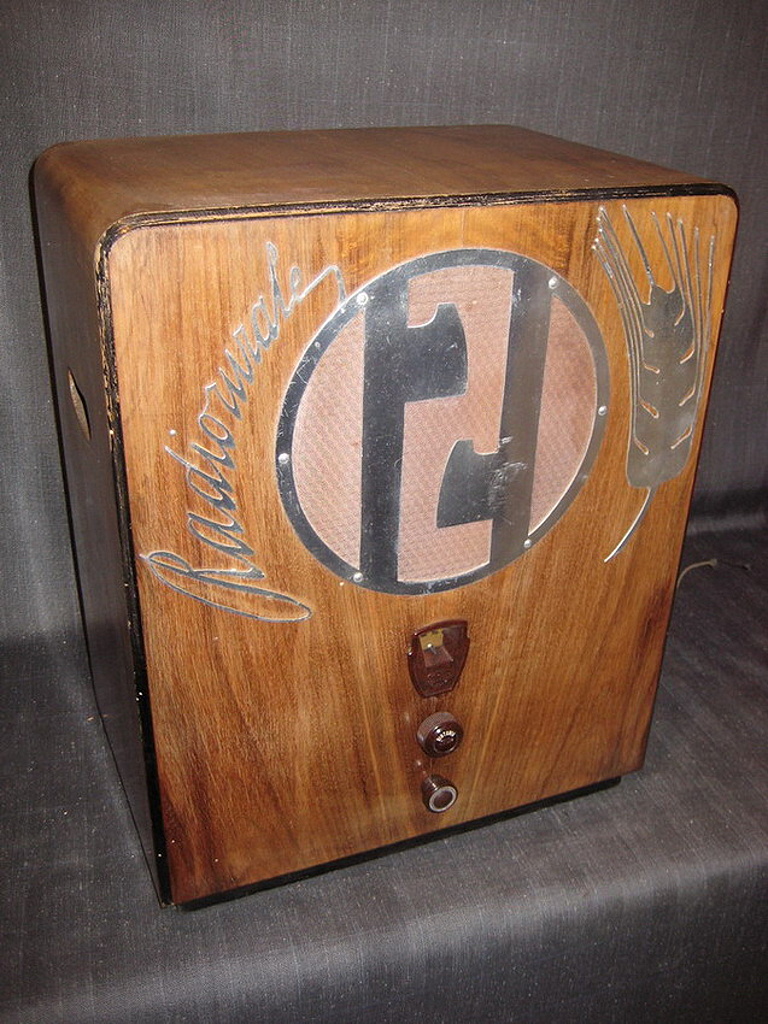
It was a complicated and expensive circuit solution for the beginning of the 1930s, obviously due to the desire to increase the quality of the received signal compared to direct amplification receivers. Below is a schematic diagram and the offal of “Village Radio” of the first series.

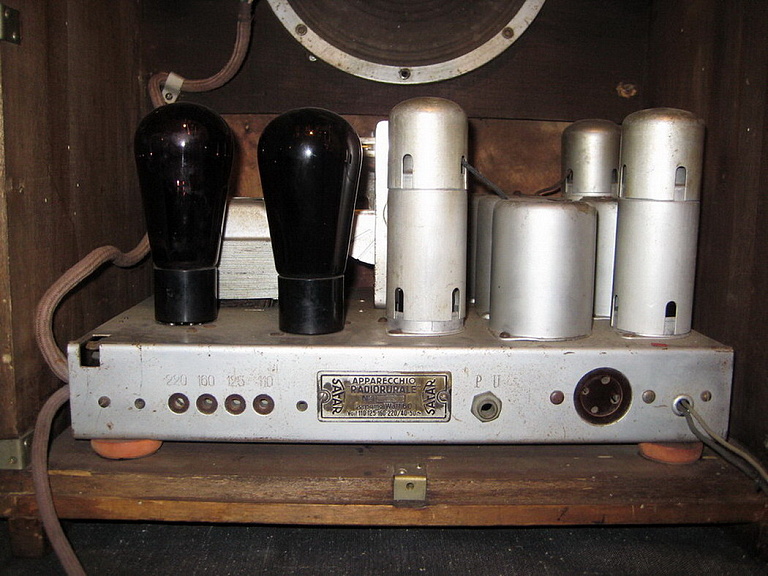
“Complex design as a reason for low technological effectiveness”
Moreover, according to the terms of reference, the device was supposed to sound legibly in rooms that can accommodate at least 60 people, and also give a good sound in the open air. The rated power of the speaker was about 18 - 20 W (RMS approx. 50 W), which is very impressive for that time.

Hinged installation did not simplify the assembly, while in Italy did not use printed circuit boards, and in the world they were very rare in the 30s
The amplifier was designed for high power, so if necessary it was possible to supplement the system with additional speakers, which were sold separately. Italian engineers, as people with a developed aesthetic and artistic thinking, decided to seriously bother with design as well. Having placed a grill in the form of fascia (a symbol of the fascist party) over the radio fabric, they thus turned the receiver into a means of visual agitation. The case was finished in polished walnut veneer, varnished.
Schools and Party Primaries
Naturally, all these solutions could not be cheap. Hence the modest circulation of devices and the need to sell at actual cost, as well as distribute as a load among party cells, schools and local administrations. Most of all, the receiver has taken root in an Italian school. So, when Mussolini created over 100 educational programs for schoolchildren of different ages in the broadcasting network. The lack of expensive home receivers forced me to listen to the radio at school. Where not too successful in terms of cost, the receiver was bought in the first place.
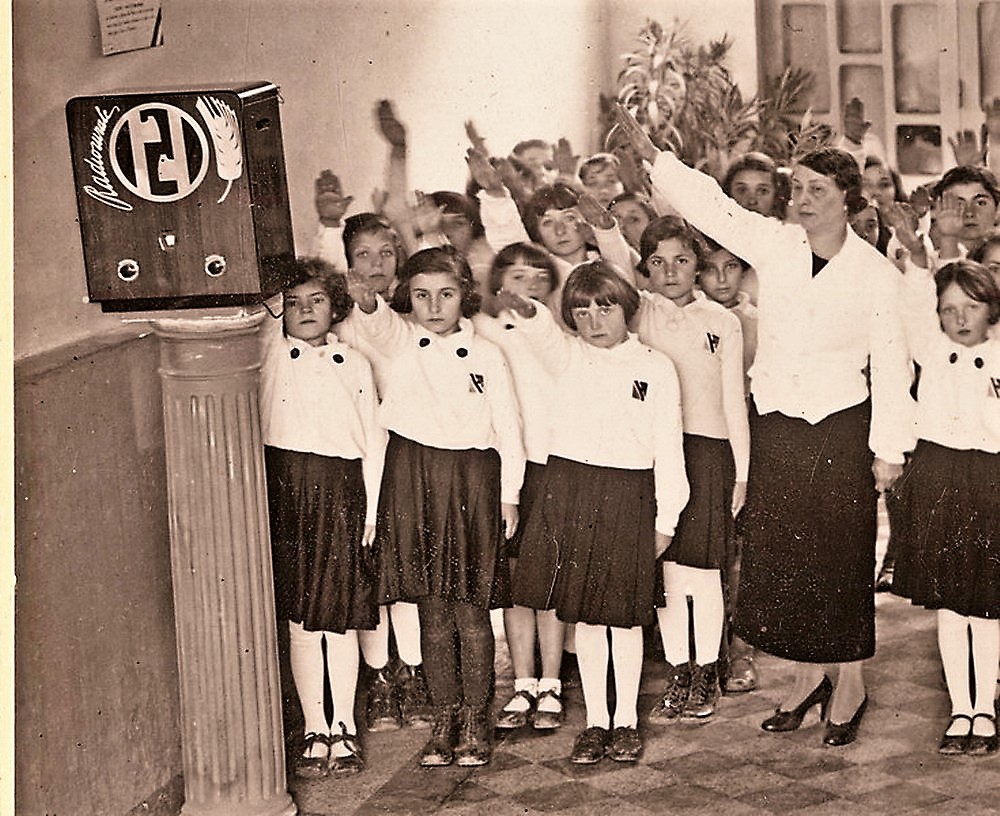
Not without censorship. Since 1937, for “Radio Rural” they began to produce an improved scale on which wavelengths and radio stations were indicated (the previous one had only symbols). At the same time, the National Directorate of Radiocommunication (EIAR) and the Ministry of Communications with special circulars forbade manufacturers to mark “hostile radio stations” on this scale. So, at first the stations of republican Spain were attributed to those, and after the start of World War II, all the radio stations of the Allies.
Failure and an easier alternative
The Italian device, despite the idea, did not become truly popular. The cost, due to universality, was available only to relatively large landowners and wealthy rural intelligentsia. Thus, receivers began to sell to organizations in installments for a fixed price of 600 lira (200 lira down payment and 10 monthly payments of 40 lira), while the manufacturer did not actually make money on them.

Buyers were exempted from the subscription fee of the listener (there was one), which amounted to about 80 lira per year. In total, 40,436 units of Radio Rural were sold from 1933 to 1939. Another receiver became more popular and actually popular - Radio Balilla. It was not conceived as “folk,” but it was simpler (three lamps and direct amplification), cheaper, and met the requirements of most Italian consumers. Also had a fascia on the grill dynamics, as a marketing technique in design, which was why it was popular with the Nazis.

Fascists with the "national receiver" Radio Balilla
German sequel
Already in 1933, the “startup” Mussolini with the “people's successor” was spotted in the NSDAP, not without the participation of Goebbels and Hitler in Germany, a program was launched to create his own national receiver. It was at its production that the interaction was rolled back within the framework of the Gemeinschaftserzeugnis - a special program for the interaction of German enterprises for the fast, efficient and mass production of radio electronics.

Government support for the program, mainly from the Ministry of Propaganda of the Reich, which became the partial beneficiary of the project, made it possible almost instantly to develop a suitable model with potentially high economic efficiency. The public receiver was created in the spring of 1933 by the engineer of the Berlin company Seibt, Otto Grace, in a building designed by the legendary German designer Walter Maria Kersting.

The device received several versions at once, in a wooden and bakelite case. According to a legend that appeared after publication in the Soviet journal “Radio Front” No. 10 of 1937, Adolf Hitler personally proposed the oak as wood for the receiver’s body, insisting on its strength. Thanks to this, the wooden version of Hitler has a higher durability compared to Bakelite counterparts.
Pricing and Advocacy Loss
Technically, the device, called the VE-301, was relatively simple. It was a direct amplification regenerative receiver with one input circuit. It was used to receive local radio stations in the NE and Far East bands. The receiver met such criteria as manufacturability, low cost, simplicity. Initially, its cost was 76 brands, which was 2 to 3 times less than the vast majority of other models.

However, this advantage in fact has become a disadvantage. As in the case of the Italian colleague, the attractive price was lower than the cost, and the difference covered the budget of the “millennial Reich,” by 1943 someone at the NSDAP finally added that time was not conducive to charity and the production of unprofitable “folk receivers” turned off . During this time, many modifications were released, including “HI-FI models for Nazi audiophiles” with a pentode amplifier, an improved speaker and high sensitivity.


Despite the losses, the Nazis considered radiofitting the whole country as a matter of special importance. Therefore, with an eye on the same rural audience in 1937, they even created a color advertising cartoon, which was shown before films in movie theaters. In the spirit of the era in the cartoon, “warm lamp terminators” ideologically “storm” the village and by brainwashing force the backward German village to order and have a happy life. Cows from thin turn into well-fed, there is a full-fledged farm infrastructure, and dull residents become satisfied. It is likely that this was the effect of the "life-giving speeches of the Fuhrer."
Cheap and cheerful
It is interesting that, as in the case of the fascist radio from Duce, it was possible to find a truly cost-effective technical solution. So in 1938 there was an improved embodiment of the concept of the national receiver, called DKE 38 (literally Deutsche Kleinempfänger). Which could broadcast the speeches of the Nazi leaders already without causing loss to the budget, but rather, generating income.
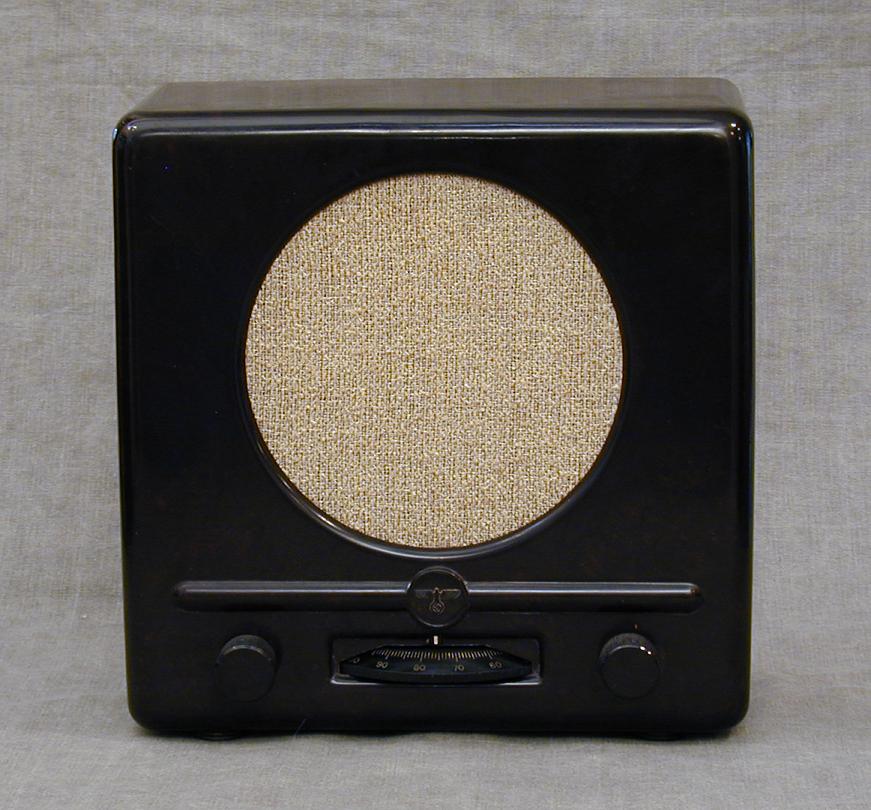
A technological breakthrough was the rejection of an expensive power transformer, instead of which a rheostat coil was used as a step-down device, as well as the use of a special composite lamp VCL11 with two systems in one housing (used as a receiver lamp and an amplifier at the same time).


Thus, the “small receiver" was able to sell for only 35 Reichsmarks, while still making a profit. For the quickest possible introduction of the novelty, which the people quickly dubbed the Goebbelschnauz, it was promoted on the 41st birthday of the Minister of Propaganda, making 500 especially distinguished German citizens a compact bakelite radio novelty.

Modular upgrade
An interesting feature was the possibility of a modular upgrade, all “popular receivers” had special connectors for the so-called additional devices - scraper (Sperrkreis). The German radio industry has produced hundreds of various upgraders of this type, ranging from simple wired signal adapters, amplifiers, noise suppressors, to expensive set-top boxes that improve signal reception and HF modules.



Shooting for the BBC and million series
Political and military realities did not remain unaccounted for. Since the public receiver could broadcast enemy voices, each model was provided with a warning of criminal prosecution for listening to the wrong stations. From a certain moment, as a responsibility for listening to all kinds of BBC, etc. the highest measure of social protection was applied in the form of execution of the poor fellow of the listener.

Warning on legislative prohibition of listening to foreign stations
Uncomplicated design and high technology have provided truly gigantic series for German folk receivers. Until 1945, in various versions of the VE-301 and DKE 38, a total of more than 3 million pieces were released. As a result, over the past ten years, the number of radio listeners in Germany has grown from one and a half million to twelve million people (according to the Third Reich propaganda ministry).
After the war, their production and modernization continued. The VE-301 and DKE 38 cases, made back in the Reich, which were in large quantities in the warehouses of the surviving industrial giants, became parts of the receivers until the end of the 70s. The upgraded versions changed the lamp filling to a transistor one, acquired printed circuit boards and acquired permanent magnet speakers, otherwise their design has not changed.
Total
From the history of production of these legendary devices, we can conclude that in an attempt to brainwash a lot of dictators, they forgot about banal economic efficiency. It turned out that the most hyped types of folk receivers essentially turned out to be unprofitable and subsidized. Meanwhile, long-term experience in mass production made it possible to find optimal technical solutions that, if they were not profitable (DKE 38), then at least allowed to “go to zero” (Radio Balilla).
The German concept of radio receivers led to the creation of industrial associations under the Gemeinschaftserzeugnis program (albeit forced) capable of producing huge quantities of electronics in a short time. Despite the fact that these associations ceased to exist in the 45th, German industrial enterprises enjoyed their fruits for a long time. Successful (from the point of view of the leadership of Germany and Italy) implementation of the concept of a national radio receiver had less obvious consequences, in Germany, for example, they began to create a national car, a national TV and a national refrigerator.
Our traditional advertising:
There are no “national radio receivers” in our catalog , but there are many modern electronics that do not brainwash your mind, but allow you to choose content yourself. With us you can easily find speakers , headphones, amplifiers, soundbars, and other useful devices. The assortment includes warm lamps, vinyl and other joys for lovers of technoarchaics. We did not forget about cold transistors and completely frosty digital devices.
Photo content and images used:
www.syracuse.com/vintage/2018/10/why_did_upstate_ny_women_send_their_wedding_rings_to_benito_mussolini_in_1936.html
engineering-ru.livejournal.com/475322.html
www.marcomanfredini.it/radio/visualizzadocumenti.php?contenuto=165&quale=64
www.radiomuseum.org/r/telefunken_radio_rurale.html
radiorurale.it/radio/?p=1735
little-histories.org/2016/03/24/svd-9
sassdelestrie.webnode.it/fatti-e-opinioni/la-radio-rurale
antiqueradio.org/KleinempfaengerDKE38.htm